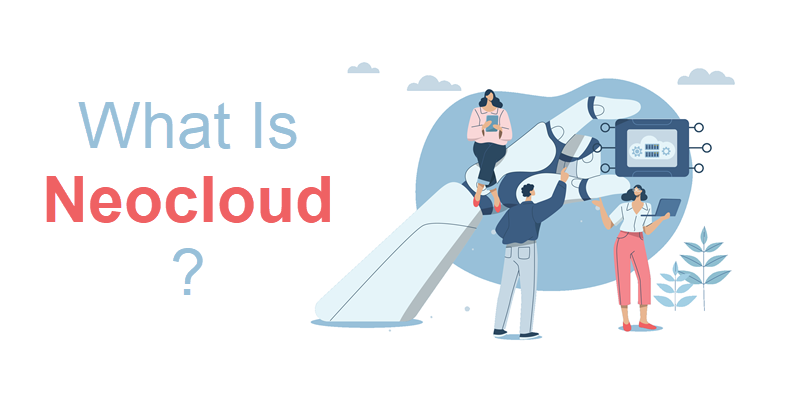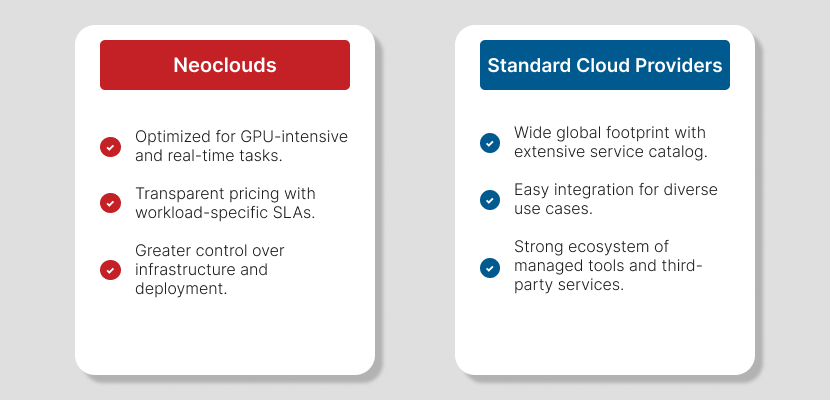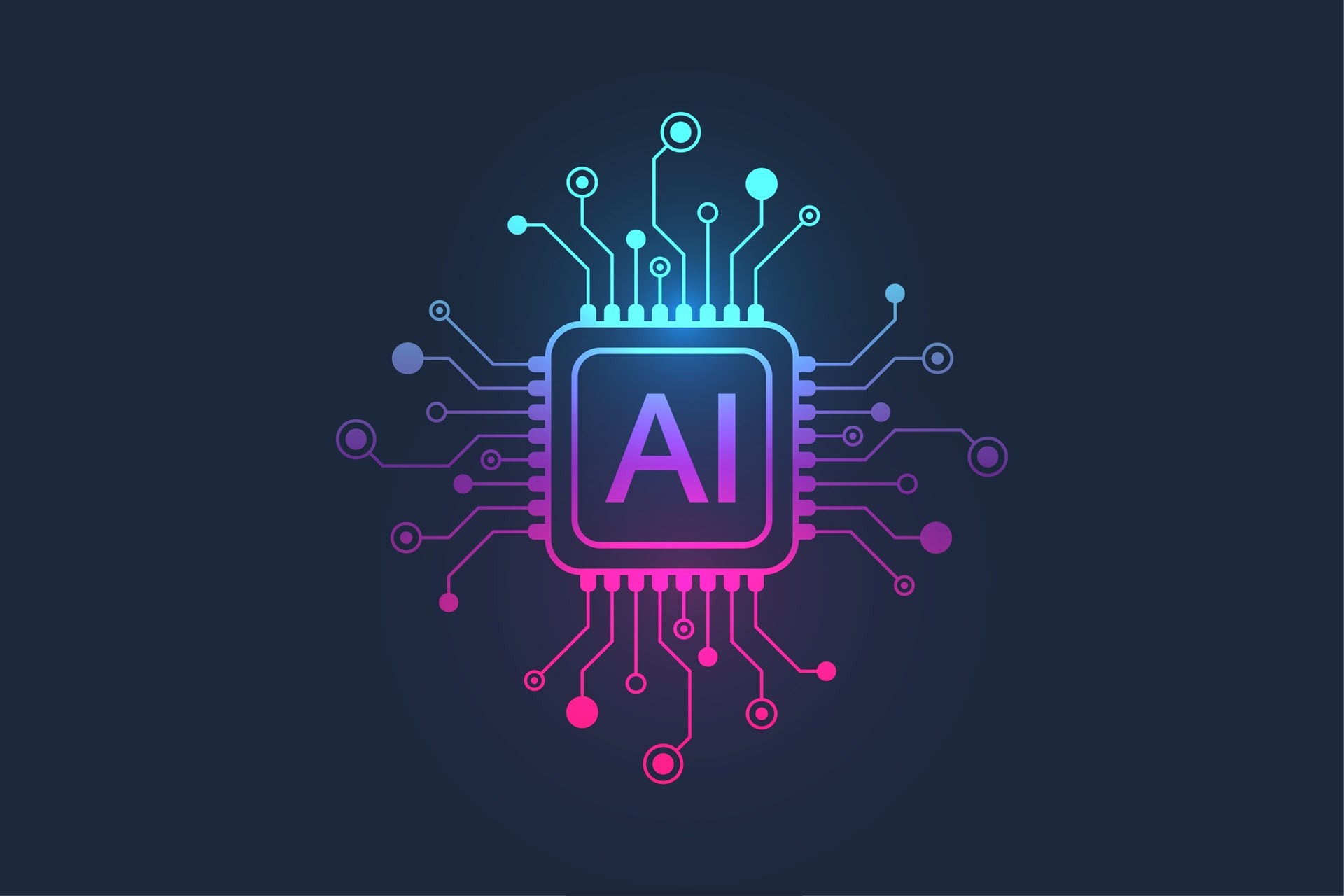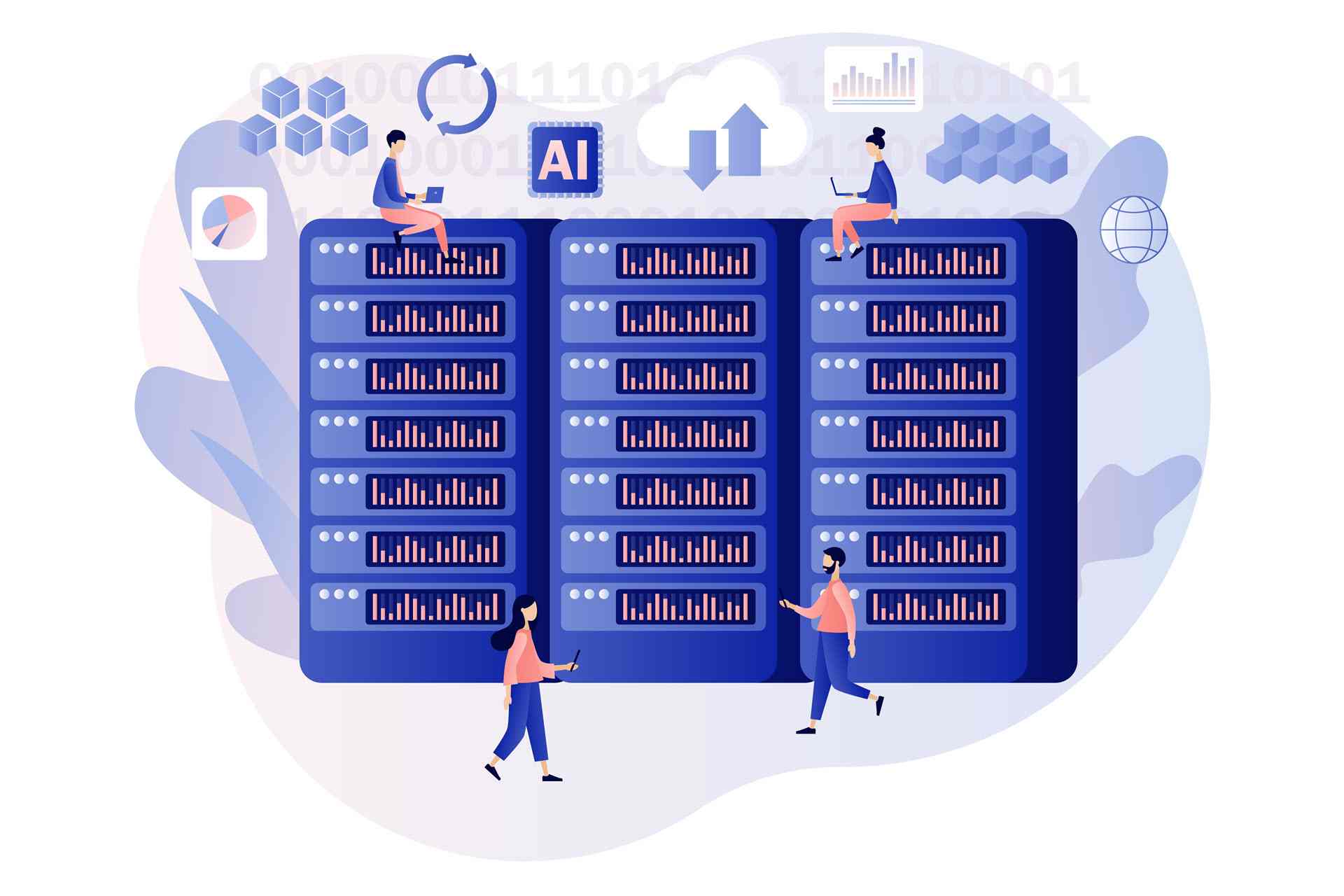The demands of modern workloads, such as AI/ML pipelines, high-performance computing (HPC), and large-scale data analytics, are often poorly served by the generalized nature of traditional hyperscale platforms. Enterprises require specialized infrastructure models that can handle heavier workloads with greater precision and consistency.
A neocloud is a new type of cloud provider that meets these advanced requirements. These platforms offer purpose-built resources and environments for GPU computing, real-time simulation, and edge computing applications. Neoclouds offer the performance, innovation, and flexibility that conventional cloud solutions often lack.
Explore how neocloud specializes in ultra-high-performance computing and why it is essential in a modern enterprise tech stack.

What Is a Neocloud?
A neocloud is a high-performance cloud platform created for compute-intensive, modern workloads. These platforms are engineered with agility and specialization to deliver infrastructure optimized for AI/ML training, HPC applications, GPU rendering, real-time analytics, and edge deployments.
"Neocloud" is an emerging, but not yet a standardized industry term.
Neoclouds tailor their environments for specific use cases. This approach differs from hyperscale providers that focus on generalized services at scale. Neoclouds enable performance tuning and addressing specific workload requirements instead.
Common Neocloud features include:
- High-performance hardware. Includes access to modern GPUs, NVMe SSD storage, and low-latency connections with high throughput.
- Workload-based SLAs. Offers depend on the workload, which suits machine learning, data science, and real-time computing availability requirements. Custom service level agreements guarantee consistent and optimal performance and uptime.
- Transparent pricing. Usage-based pricing models with granular cost visibility help avoid vendor lock-in and over-provisioning.
- Container-native orchestration. Offers built-in support for Kubernetes, GPU schedulers, and CI/CD tools for seamless DevOps implementation and AIOps. The level of management varies from fully managed to user-provisioned clusters with enhanced features.
Neoclouds deliver precision by aligning infrastructure capabilities with modern software demands. They are a specialized alternative to "one-size-fits-all" models of traditional cloud providers.
Learn more about cloud computing costs and IT cost reduction to prevent overspending on resources you do not require or use.
Neocloud vs. Standard Cloud Providers
Standard cloud providers create infrastructure with a generalized design to address broad, multi-tenant use cases. They offer a global presence and a variety of services, but often introduce complexity and hidden costs. These hyperscale platforms often lack workload-specific optimization and architecture.
In contrast, neoclouds focus on tailored infrastructure for GPU-based demanding workloads. Rather than dispersing their energy on a range of services, they excel in doing fewer things, but doing them well.

The key ways Neoclouds differ from standard cloud providers include:
- Performance density. Neoclouds often deliver better compute power per dollar for specific workloads by focusing on high-throughput infrastructure instead of scalability.
- Specialization. The architecture focuses on GPU-intensive tasks rather than generic web or application hosting services.
- Transparency. Users have a clear overview of their hardware and location, including physical server specifications, deployment region, and often rack-level availability. Performance is predictable, and there are fewer abstraction layers, which enables developers to fine-tune performance and optimize workloads without virtualization overhead.
- Specialized support. Neoclouds often have engineering support with workload familiarity rather than a generalized service desk.
Focusing on precision and performance, rather than addressing general needs and coverage, Neocloud provides an efficient solution for companies with demanding modern workloads.
Why Are Neoclouds Important?
Standard infrastructure often fails to meet the needs and demanding workloads of modern enterprises. Organizations often become constrained by limited resources, latency, or inefficient scaling. On the other hand, they require real-time responsiveness and rapid innovation.
Neoclouds bridge this gap by providing purpose-built platforms to address modern computing challenges. They enable organizations to:
- Improve operational efficiency. Businesses avoid overpaying for services that are either unused or don't meet their requirements. The infrastructure is tailored for specific tasks, resulting in better cost-to-performance ratios.
- Speed up innovation cycles. Neoclouds provide optimized environments to help eliminate bottlenecks. AI model training, deep learning, and simulations require demanding and continuous access to computing resources.
- Provide better workload alignment. Fine-grained resource control allows enterprises to better align with their workload requirements. Neoclouds help simplify business decisions and provide consistency and reliability.
- Future-proof essential systems. Neoclouds follow computing trends, making them well-suited for long-term growth. They enable horizontal scaling and help address growing workload demands.
Neoclouds represent an essential evolutionary step in cloud infrastructure, empowering businesses with specialized systems rather than merely being just another alternative.
GPUs offer a significant performance boost, particularly for deep learning applications. See our in-depth guide on GPUs for deep learning to learn more about how they affect specific tasks and which ones we recommend.
Neocloud Use Cases
Neocloud platforms are gaining popularity across industries where GPU-based workloads are essential. Examples of real-world use cases include:
- Edge and industrial AI. Enterprises and startups rely on neoclouds to train and fine-tune models at scale. For example, autonomous vehicle companies simulate millions of driving scenarios, train perception models, and process sensor datasets. GPU clusters and low-latency architecture enable real-time feedback loops that are essential for vehicle safety systems.
Most autonomous vehicle companies use hybrid cloud environments to further lower cloud computing costs and address data sensitivity.
- Scientific research. Academic institutions and research companies utilize neoclouds for demanding workloads, including simulations, genomics, and data modeling. For example, biotech companies accelerate their workload, which includes molecular simulations, drug discovery, and protein folding analysis. Precision, computing power, and data access are essential during clinical trials and screening.
- Media production. Content creators and media studios use neoclouds for 3D rendering, video processing, and visual effects. The setups help maintain quality and meet production deadlines.
- AI and ML development. Startups and larger companies use neoclouds to prototype and scale specialized AI tools. Examples include companies that develop LLMs, real-time speech processing, fraud detection engines, recommendation systems, and similar tasks.
Artificial intelligence risks include unethical uses, data privacy concerns, bias, over-dependence, and more. When developing with AI, consider researching AI ethics and how to establish guidelines to prevent its misuse.
What Influences the Growth of Neoclouds?
Technological, economic, and operational factors all contribute to reshaping the needs of enterprise infrastructure. Businesses are slowly outgrowing general-purpose cloud models and instead require specialized, high-performance environments to stay competitive.
The main drivers of neocloud growth include:
- AI/ML demands. The exponential and explosive growth of generative AI and LLMs necessitates infrastructure with increased GPU power and enhanced performance control.
- Edge computing. Autonomous systems and real-time manufacturing increase the need for edge computing. Neoclouds enable edge-focused deployments with greater hardware control.
- Efficiency pressure. Enterprises are constantly pushing back against over-provisioning and hidden billing costs that often happen with hyperscale providers. Neoclouds offer insight into actual consumption and usage-based pricing models.
- Colocation and infrastructure partnerships. Facilities with high-density power and cooling enable GPU-based cloud providers to scale without having to build a physical data center. Colocation enables these technologies to quickly enter the market and grow through bare-metal focus, direct cooling, or high GPU density.
phoenixNAP's colocation services include a secure, high-performance infrastructure with global connectivity. It's ideal for businesses that require reliability and control without having to manage hardware on-premises.
Learn more about colocation at phoenixNAP.
Neoclouds and AI
Neoclouds directly address the challenges and flexibility required to support generative AI, deep learning, and similar tasks. These workloads are often unpredictable, require consistent performance, low-latency networking, and are compute-intensive.
Neoclouds are optimized for AI in business environments by design at every stage of the pipeline:
- Model training. Neoclouds use bare-metal GPU clusters and high-bandwidth storage. This setup enables fast and efficient training of large models, including language, computer vision, and deep learning datasets.
- Inference. Inference requires predictable performance, whether it's for computer vision on the edge or real-time chatbots. Neoclouds avoid resource contention and ensure reliable responses when under heavy load.
- Integration. AI systems require heavy integration to ensure data ingestion and preprocessing work seamlessly. Neoclouds feature high-speed interconnects and integrate with container-native workflows to simplify building scalable and automated pipelines.
- Experimentation. AI teams require flexible frameworks, custom environments, and room to test new tools and iterate rapidly. Neoclouds support this by offering configuration control and complete visibility into hardware usage. They also support MLOps tools for versioning, tracking, and automation across training and deployment.
The coordination between neoclouds and AI makes them a natural choice for organizations that are AI-centric. As the field continues to evolve, neoclouds are becoming an essential part of the AI technology stack.
phoenixNAP offers on-demand GPU servers with dual Intel® MAX 1100 GPUs to help you maximize the benefits of AI, ML, and HPC technologies.
Neocloud Advantages and Disadvantages
Neoclouds are designed for specialization, performance, and control. However, as with any infrastructure model, there are some trade-offs. Knowing both the advantages and disadvantages is essential when making an informed decision. The sections below outline both the benefits and limitations of neocloud platforms.
Advantages
The main neocloud advantages include:
- Specialized performance. High-density computing, GPU acceleration, and optimized networking are all essential for AI, HPC, and real-time workloads are generally not available with general-purpose clouds.
- Resource control. Infrastructure addresses specific needs and allows better control based on application demands. This reduces resource waste and improves consistency.
- Pricing. Neoclouds often have transparent and usage-based billing models with fewer abstraction layers. Organizations can calculate and control costs better to avoid over-provisioning.
- Flexibility. With deeper infrastructure access, developers can create custom environments and exert direct control over resources. There are fewer vendor-imposed limitations, resulting in operational flexibility.
- Edge ready. Neoclouds typically support decentralized and regional deployments, making them ideal for edge AI and latency-sensitive use cases.
- Data locality. Neoclouds provide greater control over the physical location of data, essential for compliance with regional data protection laws, such as GDPR.
Disadvantages
Some disadvantages of Neocloud are:
- Fewer services. Compared to hyperscalers, neoclouds lack managed services, marketplace integrations, add-ons, and the global reach that enterprises are used to.
- Limited scalability. Neoclouds often rely on colocation or regional partnerships. Their availability is constrained by physical data center locations, which may be limited to specific regions.
- Operational overhead. Additional control over hardware adds operational overhead. Teams must manage aspects that are fully abstracted in standard cloud environments. It may require additional expertise and time to address these responsibilities.
- Lesser-known. Enterprises with strict compliance requirements may hesitate to adopt lesser-known technologies, even if it is superior for their use case.
Check out our blog post on AI Neocloud to learn how Neoclouds are beneficial for AI.
How to Choose a Neocloud Provider?
Choosing the right neocloud provider requires careful evaluation of specific workload demands and their infrastructure. Neoclouds vary in specialization, hardware focus, and deployment flexibility. They lack a general-purpose approach compared to cloud platforms, so careful evaluation is necessary.
Consider the following factors when selecting a neocloud provider:
- Workload. Ensure the provider supports your specific use case to ensure compatibility. Verify that the SLAs align with your workload's uptime, performance, hardware replacement, and support escalation requirements. Check if the provider offers transparent access to hardware via technologies like bare metal servers, and if passthrough options are available (e.g., GPU passthrough via PCIe).
- Hardware. Review the types of GPUs, CPUs, and storage that are available, along with their corresponding performance specifications. See if the provider is transparent about direct access to hardware through technologies such as bare metal servers or if there are passthrough options (such as GPU passthrough via PCIe).
- Deployment. Select a provider that supports the appropriate regions or edge locations for your business. Consider low latency and data sovereignty early if those factors are critical.
- Pricing. Find a provider with usage-based pricing models that avoid hidden fees. Compute-heavy workloads can become expensive quickly, so cost predictability is an essential factor.
- Tooling. Ensure the provider has an ecosystem that is compatible with your technology stack (Kubernetes, CI/CD pipelines, deep learning frameworks, Terraform, Pulumi, etc.).
Selecting a neocloud provider should be about forming a partnership that grows with your long-term compute needs and offers flexibility.
Neocloud: The New Cloud on the Block
Neoclouds represent the next advancement in cloud infrastructure. Although they are not a replacement for general-purpose clouds, they meet the modern computing demands of AI, HPC, and other performance-heavy tasks.
As organizations turn to innovation, neoclouds can be deployed alongside general-purpose clouds in multi-cloud or hybrid cloud strategies.



